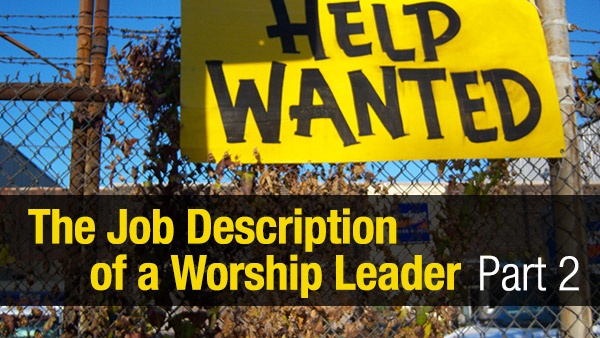
Written by JD Walt, Chief Sower at Seedbed Publishing
It is a weekly reality for me. A pastor or church leader will call me asking me who I know that could be a great worship leader for their church. It doesn’t take long for me to see what they are really after. They basically want a skilled musician who can develop and lead a band and create worship experiences geared for people who don’t like traditional worship services.
For the past several years I’ve enjoyed reading and thinking through a short essay on worship entitled, “Planning and Leading Worship as a Pastoral Task,” by John Witvliet, the director of the Calvin Institute of Christian Worship. He breaks down the most common way we think about these people as follows:
- Craftspeople– weaving together all the various elements to help a worship service come together.
- Directors and Coordinators– Recruiting musicians, running rehearsals, choosing media, and doing it for multiple services and multiple congregations week after week.
- Performers–Sharpening and honing one’s own set of gifts and skills in preparation to make the best possible offering to God.
- Spiritual Engineers– Constructing moments and movements and creating environments that help usher people into the Presence of God.
He then proffers this analysis,
“As worship leaders, we have the important and terrifying task of placing words of prayer on people’s lips. It happens every time we choose a song and write a prayer. We also have the holy task of being stewards of God’s Word. Our choices of Scripture and themes for worship represent a degree of control over people’s spiritual diets, over how they feed on the bread of life. For holy tasks such as these, the church needs more than craftspeople, coordinators, and performers, and none with the hubris to be spiritual engineers. The church needs pastoral people to plan and lead its worship.”
So what does the church need most in its worship leaders? What are the essential elements of the job description? I’ve given this a lot of thought over the past ten years. Here’s a start on how I see the job description of anyone tasked to lead the worship of God.
1. Biblical Memory & Theological Imagination.
Worship leaders and designers more and more serve as the primary theologians of the church. On a weekly basis in a typical church they stand in front of the people and offer more leadership than any other person. Are they leading us into a spiritual experience of “God” through music and media or are they using music and every other means available to narrate us more deeply into the story of Scripture? Are they growing in the capacity to help us remember? Literally speaking, are they re-membering or reconnecting us to our primary story?
Somewhere along the way over the past few decades, someone decided that worship services need to be structured around the ideas or themes being presented in the sermon. While this might make for a compelling presentation, it so often misses the point of worship. Worship must be more about encounter than education; more beholding than behavior modification and story-centric rather than sermon-centric. Worship can never be sublimated to even our best and most biblical agendas. Do our worship leaders and designers understand that a worship service is a place for remembrance and revelation and not for our neat thematic ideas?
2. A Priestly Mind and a Pastoral Heart.
More than taking us on a spiritual journey, worship leaders have the task of orienting us inside of the presence of God. Are we the loyal subjects “down here” worshipping a distant Sovereign who is “up there?” Or are we being ushered by the Spirit into the family room of God as the Sons and Daughters whose hearts cry Abba? While these are not mutually exclusive realities, the latter does not necessarily follow upon the former. Are they growing in the capacity to help us worship an unreachable God who has made himself touchable?
Do our worship designers and leaders create space for confession and repentance? Are there meaningful opportunities to lament or is it one happy song after another? Do they realize that silence can be as significant as singing?
3. Prophetic Vision and Intercessory Intention.
Are our worship experiences an emotional escape from Earth into a nirvana like experience of Heaven? Or does worship lead us to engage the suffering and brokenness in the world. Think about your last worship experience. You had an audience with Father-Son-Holy Spirit. Did anyone mention the hungry, the poor, the weak, the sick, the imprisoned or the strangers in our midst?
Keep in mind, the symbol at the center of our sanctuaries is a sign of immense unjust human suffering. As the faces of the downcast and dispossessed are visualized in our sanctuaries they will become far more visible to us in the streets. According to the Bible, the big question at the judgment will not be God’s question of us but our question back to God, “Lord, when did we see you?” Is the shape and structure of our worship training us to live intercessory lives? Are our would be worship leaders growing in the capacity to help us intercede and intervene?
Closing Thoughts
So there it is. This is what I think we most need in our worship designers and leaders. While much good has come from the expansion and innovations in contemporary worship over the past twenty years, I fear that in recent years the work of worship is becoming over-focused on the technical issues of generating a certain kind of experience for worshippers and under-focused on the theological dimensions of an encounter with the living God.
Do you agree? What do you think we most need in our worship leaders?
Seedbed Publishing is based in Franklin, TN. They are aimed toward resourcing individuals, communities, and movements to love the whole world with the whole gospel. Seedbed is sowing the whole Gospel into the whole world, uniting voices around a shared vision and publishing resources that awaken the Wesleyan movement for the 21st century church.
You can find out more about Seedbed here, or check out J.D.'s blog for more though-provoking posts.



















